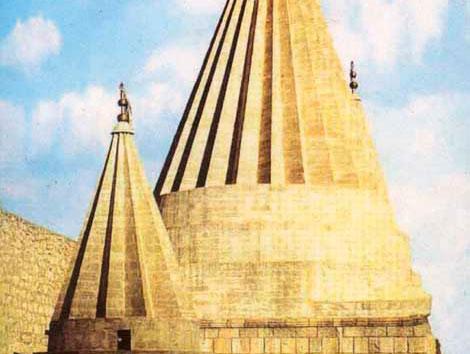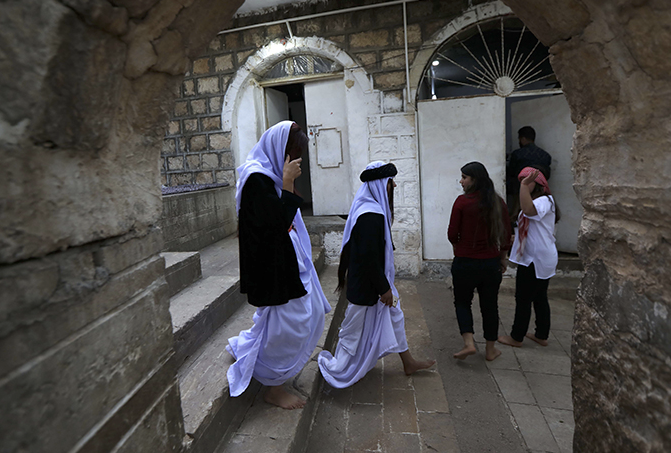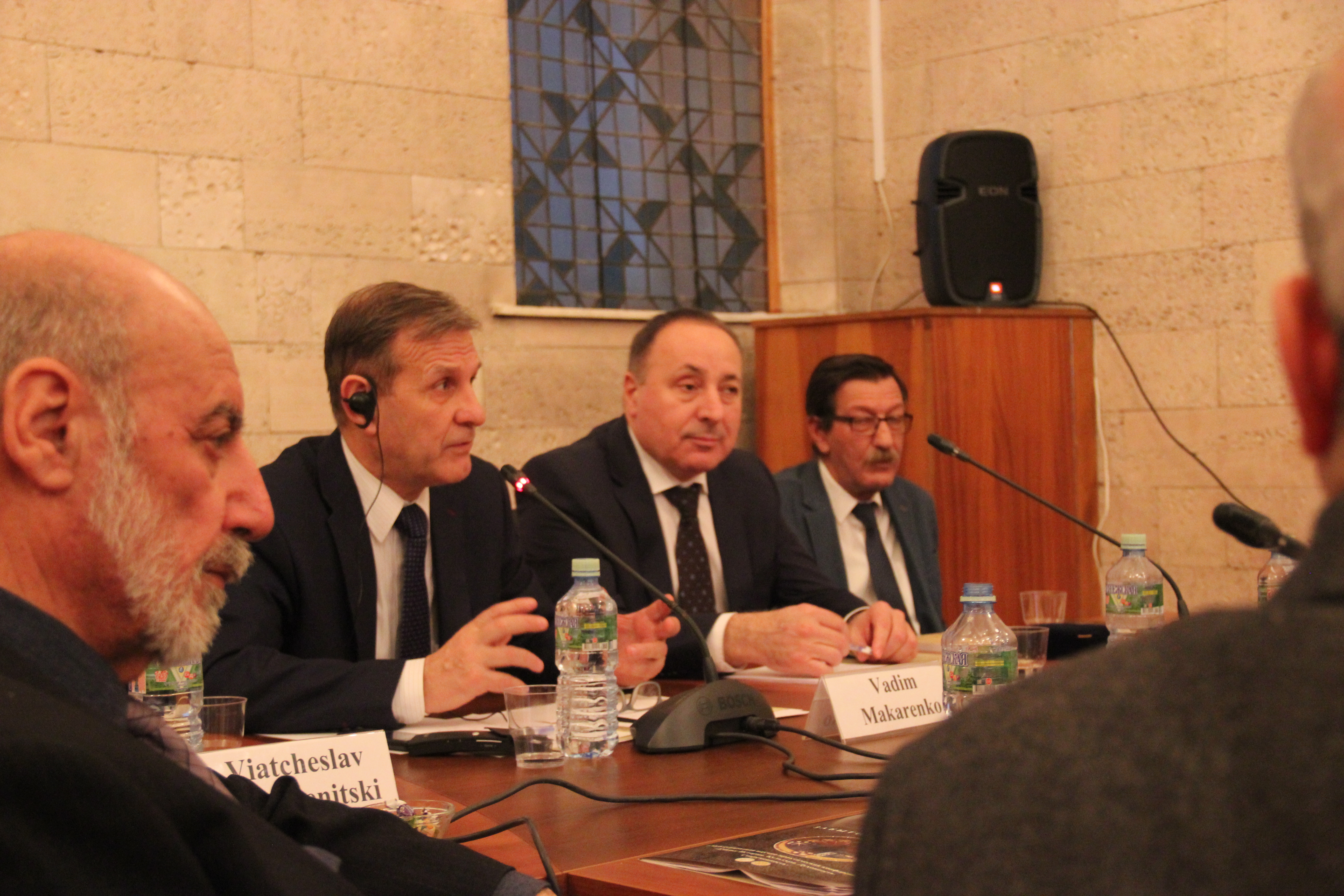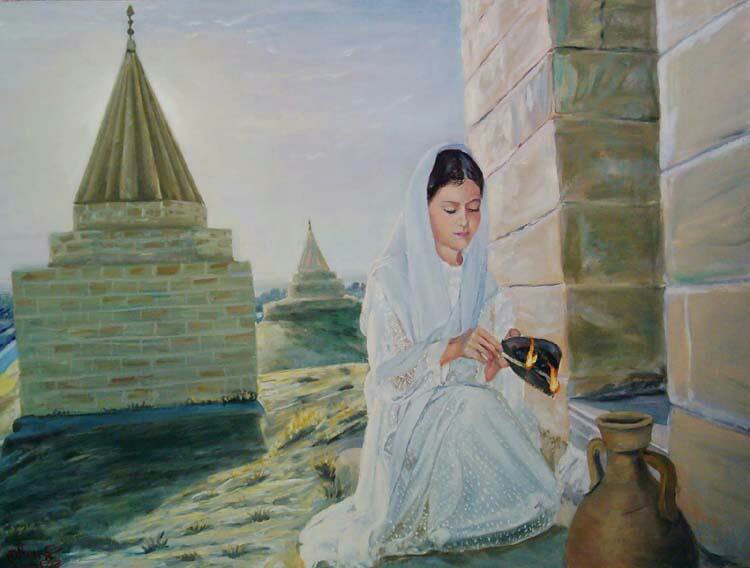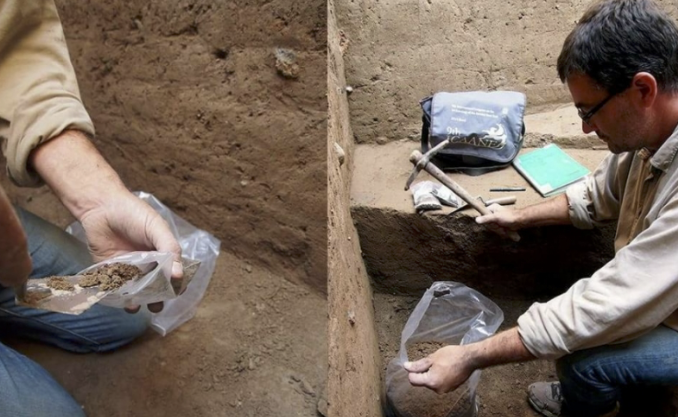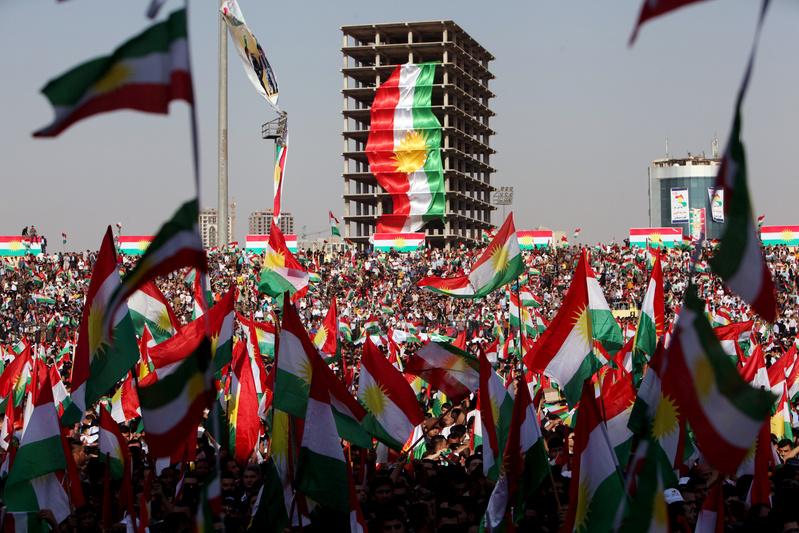Articles
On the Kurdish question: history and present
pmli.it / 20 июля 2017 года
The Kurds are a people with no recognized motherland. This people, that proclaimed themselves to be so in 600 AD, currently live in the mountain region where they have always lived—Kurdistan, with a population of almost 30 million people, stretching over a 500,000-square-kilometer wide territory in six countries of the Middle Eastern and Asian area: Turkey (south-east), Iraq (north-east), Syria (north-east), Iran (west), Armenia (south) and Azerbaijan (south-west). Most of Kurdistan is located within Turkey’s borders, in an area of about 230,000 square kilometers (30% of the Kurdish territory). It is a territory strategically relevant as it is rich in petrol and water resources. 75% of Iraq’s oil comes from here, Turkey’s only oil fields and Syria’s most important ones are in Kurdistan, and oil is produced also in the Kermanshah area, an Iranian region inhabited by Kurds. The country occupies most of the mountain region stretching north from the Black Sea, until the steppe of Mesopotamia to the south, beyond the Zagros mountains to the east. This area of high mountains—some of them, such as Mount Ararat, are higher than 5,000 meters—is the source of several rivers, including the two great Biblical rivers, Tigris and Euphrates, flowing for hundreds of kilometers before reaching the Arabian lands of Iraq and Syria, and finally rushing into the Arabian-Persian Gulf. Some important communication ways also must necessarily pass through this territory, for example between Central Asian republics, Iran and Turkey, and it is at the core of one of the hottest points of world politics. A geopolitical position that has heavily conditioned the history of the Kurdish people.
HISTORICAL NOTES
The history of the Kurdish people begins in very remote times. They descend from ancient Medes, an Indo-Iranian people who left Central Asia in 614 BC to reach the mountains of Iran. In the 7th century, Kurds converted to Sunni Islam, giving a mainly military contribution to Muslim society. Salah ad-Din (Saladin), sultan of Egypt and conqueror of Jerusalem in 1187, came from the Kurdish tribe of Rawadi. Kurdistan then was divided in 1639 between the Ottoman and Persian empires (Kasiri-Sirin agreement), and the Ottoman Empire imposed strong limits to independentism from the early 20th century resulting in a number of uprisings aiming at the unification and the autonomy of the Kurdish people, whose fate tremendously changed with the disbandment of the Ottoman Empire at the end of the first imperialist world war. Kurds fought for the Turkish Republic during WWI against the French and the English, who had occupied Kurdistan together with Germany, in exchange for the promise to have their own identity acknowledge. From 1916, in the middle of the war, the “allies” started secret talks to divide the remains of the Ottoman Empire. French, English and Russian delegates signed a convention known as the “Sykes-Picot Agreement” (after the names of Britain and France’s foreign ministers), which outlined the respective areas of influence: the British area included Mesopotamia, Palestine and Jordan, the French area included Syria and Lebanon. Mosul province, or Southern Kurdistan, was divided into two zones: the north, including Mosul, fell under the French influence, while the south, with the oil-rich region of Kirkuk, under the British influence. Sazanov, Russia’s foreign minister, who was informed of the agreement, gave his consent on 26 April 1916 as long as the northeastern districts of Turkey, including Trebizond and northeastern Kurdistan, were given to Tsarist Russia. With straight lines, the borders of these areas divide the Kurdish territory and people into four countries. Conflicts between peoples of the region and the great powers arose, but they were dealt with by British and French imperialist armies.
The Treaty of Sevres in 1920 recognized the right for the Kurdish people to have their own state, but the following Treaty of Lausanne rejected it, preventing the establishment of any independent Kurdish state and laying the foundations for the following policies of political, economic and cultural discrimination of the Kurdish people, formally scattered across different countries. Oil appetites of Europe’s great powers and the ambiguous policy of Mustafa Kemal Ataturk in Turkey had won. The Society of Nations decided on the annexation of Mosul province, including Kirkuk oilfields, into Iraq (under British mandate) in 1925. Ottoman Kurdistan was divided between three states (Turkey, Iraq, Syria), while Persian Kurdistan remained within Iran’s boundaries.
So began the struggle of the Kurdish minorities in their countries, a political-cultural struggle at first, and then also a military struggle. Kurdistan became a sort of an imperialism-ruled international colony.
Considering the uneven composition of the Kurdish people, a feudal system where many dialects were spoken and different religions were practiced, Turkey wanted to occupy one region after another, planning a control of the Kurdish territory at large. Many uprisings took place (1925, 1930), but they were bloodily suppressed. The peak was in Dersim in 1937, when thousands of revolting Kurds were massacred by Kemal’s troops, and the city’s name was changed into Tunceli. The Turkish government slaughtered thousands of Kurds who refused to give up their identity and accept Turkey. All their traditions, even traditional clothing and music and dance gatherings, were abolished in 1932. Any Kurdish ceremony was banned. The Kurdish national costume was banished, and a law forbad using the Kurdish language. The word “Kurdish” was cancelled from the official vocabulary, replaced with “Mountain Turks,” “Eastern Turks,” and Kurdistan became “Eastern Anatolia,” “Eastern Region.” Kurdish cities and villages were given Turkish names.
The Turkish regime changed its strategy after 1940, switching to assimilation, but the goal remained unaltered, by placing Turkish schools in every city and village. Children, taken away from families, were forced to attend schools until the age of 16-17, strictly forbidden from speaking Kurdish. They could meet their parents only once or twice a year. Many family members of who had taken part in the uprisings were exiled.
STALIN’S SOVIET UNION AND KURDS IN IRAN AND AZERBAIJAN
The democratic movement experienced a huge rise at the end of World War II in Azerbaijan and Kurdistan, where it had merged with the struggle of Azerbaijanis and Kurds for the autonomy of these territories within the Iranian state and for the establishment of democratic and national regimes. In Kurdistan the struggle was led by the People’s Party of Kurdistan. In August 1945 the Democratic Party of Kurdistan was founded in Iranian Kurdistan. One year later, on 16 August 1946, the Iraqi Kurds’ party was founded in Baghdad under the leadership of Mustafa Barzani. In December 1945, thanks to the strong support by Stalin’s Soviet Union, the people of this region gained autonomy within Iran and formed an autonomous government. Qazi Mohammad, the highest ranking religious notable in the capital Mahamad, was nominated president. The USSR supported the new Kurdish government with arms, money and even a modern typography. It was an exceptional experience participated by many Kurdish leading figures from Iraq and Syria, including Mustafa Barzani.
Lenin’s many writings on nationality inspired the action of the Kurds in Persian Kurdistan after the October Revolution. Many Soviets were established there, and in 1923 a Kurdish regional autonomy was even proclaimed in Azerbaijan, with Lachin as its administrative capital. In general, the Kurdish people experienced an unprecedented social and cultural development. Kurdish-language schools and theaters were opened, schools, books and newspapers were published. Starting from 1921, the Soviets promoted the large-scale alphabetization of the Kurdish people. Attending school was mandatory. Before the October Revolution, 99% of Kurds were illiterate, but literacy was accomplished by the end of the 1930s. The Soviet republics of Armenia, Georgia and Azerbaijan by 1930 had opened schools taught in Kurdish, and courses in Kurdish language and literature were held in the universities of Moscow, Leningrad, Erevan and Tashkent. Now, thanks to Soviet typography, Kurdish-language school books, literary journals and newspapers were published.
The Kurdish flag replaced the Iranian flag over the justice department building in Mahabad on 17 December 1945, and the first Kurdish republic in history was proclaimed on 22 January 1946, backed by local tribes—Mamash, Maengur, Gawurk, Zarza—as well as other tribes, such as Shikak, Jalai, Herki, Begzadeh, Milani and Barzani.
During the existence of the Kurdish autonomous regime, land reform was carried out in the region, and peasants were given state lands and lands confiscated from reactionary landlords fled to Tehran for free, labour and social protection laws were promulgated, the working day was limited to eight hours, parity between men and women was proclaimed, and Kurdish language was taught in schools.
Iran’s reactionary circles, believing in the impossibility to curb alone the democratic movement growing in the country, asked Great Britain and the US for help. Backed by London and Washington, Tehran brought the “Iranian” issue to the UN Security Council in January 1946. Showing the people’s movement in Kurdistan as a product of the Soviet military in the area, Iranian reactionaries tried to accuse the USSR of meddling with Iran’s internal affairs.
Talks with the USSR were started by Qayam al-Saltana’s Iranian government in Moscow in February 1946, and ended in Tehran by signing a joint communiqué on 4 April 1946. The two sides agreed on evacuating Red Army troops from Iran within one month and a half, granting the opening of an Iranian-Soviet mixed oil company. In June 1946, Tehran’s government officially acknowledged the autonomy of Kurdistan. Qayam’s attitude, however, was not sincere. Hiding behind democratic slogans, the government was preparing its counter-attacks against the democratic movement in the country. From September, Iran’s reaction started its open attack with British and US support. Troops formed by elements of Bakhtiyari and Qashqai tribes ignited a revolt, killing members of the People’s Party of Iran, trade union members and peasants union members. “National security” black gangs intensified their terroristic actions, together with police and gendarmerie. On 10 December 1946, with the excuse of “securing order” and “freedom of election” for the future parliament, the military was sent in Iranian Azerbaijan and Iranian Kurdistan to carry out bloody repressions against the democratic movement. Kurdistan’s administrative organs were suppressed and their democratic gains were reversed. Thousands of democrats were jailed, exiled, hanged, and executed. Mass arrests were carried out across Iran. Punitive expeditions were participated by American advisors. President Qazi Mohammad was hanged, while Barzani, who was leading the Kurdish military, was able to flee to the Soviet Union with a hundred of partisans. On a proposal by the US, the Iranian government denounced the 1946 agreement with the Soviet Union, which was officially cancelled by the Tehran parliament on 22 October 1946.
THE STRUGGLE OF KURDS IN IRAQ, SYRIA AND TURKEY
After an 11-year exile in the Soviet Union, Barzani went back to Iraqi Kurdistan after the republican regime led by Kassem took power in Iraq. After a brief period of reconciliation and coexistence, Barzani and his movement—the Kurdish Democratic Party (KDP)—took up arms again to fight against the Baghdad central government (1962-1963). With an army strong of 70 thousand Peshmerga (literally: “death fighters”), Kurds carried out multiple insurgencies in Iraq and Iran. On 11 March 1970, Iraq’s new regime signed a deal with the KDP partly acknowledging the Kurds’ demands, recognizing them as the second nation (together with Arabs) of the country. Later on, Barzani, now openly sided with the US (after the Iraq-USSR treaty of 9 April 1972, US President Nixon approved a CIA plan sending 16 million dollars to Barzani over 3 years), returned to Iran, fleeing it after Khomeini’s Islamic revolution in 1979 and ending his days in the United States. Part of the KDP, led by Barzani’s son, Masoud, joined Iraq’s Progressive National Front. On 11 March 1974, an autonomous region with Erbil as its capital was established in Iraq, significantly excluding the Kirkuk oil-producing area. The conflict between the Kurds and Baghdad, however, started again in the late 1970s.
The DPK Syrian branch was established in 1957, but then Syria suppressed the Kurds in 1962-63 with an Arabization process of Syrian Kurdistan, carried out by Hafez al-Assad for decades. Roughly 300,000 Syrian Kurds were deprived of their citizenship and starting from 1962 until the civil war in 2011 they lived as de facto stateless people, accused to be irregular immigrants in Turkey, with significant consequences in social, economic and political margination. A 12-point decree officially outlined this policy that led Arabs settling in the region inhabited by the Kurds, forcing them to exile. The Syrian government attracted Arabs by offering them economic incentives and making them settle in Arab villages so to cut communications between remaining Kurdish villages. The Kurdish language was forbidden in Syria’s press and society, and names of cities and historical places were Arabized. Together with the cultural genocide, the Assad regime also carried out physical suppressions against the Kurds. The most tragic event occurred on 12 March 2004 in Qamislo during a soccer match, when Syrian government forces together with Arab nationalists attacked the Kurds, killing thirty of them, injuring and jailing hundreds. These events pushed the Kurds to organize politically and militarily against the regime of Bashar al-Assad, Hafez’s son.
However, it was Hafez al-Assad’s regime the one that made the widest use of Kurdish guerrillas as a proxy war method against Turkey in the 1990s. Syria’s relations with Turkey were very tense due to the control of water resources of Tigris and Euphrates, not to mention old rivalries for their siding with different blocs during the conflict between US imperialism and Soviet social-imperialism. Allied with Breznev’s social-imperialist USSR, Syria was even dubbed “the Cuba of the Middle East”. Damascus became a safe haven for Kurdish guerrilla fighters using Syria to attack Turkey. The situation became so unbearable for Turkey that Ankara’s reaction almost led to an armed conflict in 1988, avoided only after Damascus decided to expel the Kurdish leading Ocalan from its territory. Ironically, while supporting Kurdish guerrilla fighters in their anti-Turkish role, Syria was also the country there Kurdish minorities lived in the worst conditions.
The powerful wind of national liberation struggles inspired by Mao’s China gave new strength to the Kurdish resistance in Turkey. In 1978, the Ocalan-led Kurdish Workers’ Party (PKK) was established and started its armed struggle in August 1984. Initially founded on Marxist-Leninist principles, the PKK was an underground party and it was forced to move to Syria and Lebanon following the US-backed military coup in Turkey in 1980. It was the only party to settle its headquarters in the Near East as other Kurdish organizations and Turkish leftist groups fled to Europe.
More than 40 large-scale military actions were carried out by the Turkish in the Kurdish areas in Turkey from 1988 to 1993. The Turkish army also used chemical weapons, mainly nerve gas in the Hani village, near Dijarbakir, along the forest areas of Ovarck and Pertek, and on Mount Gabar, an hideout for PKK fighters. Entire districts were bombed by Turkey with chemical weapons in 1991 and 1992, with Palamut, Umurlu, Eskicek, Bassine, Emte and Erzurum being heavily hit. Mount Nurhak area was attacked in 1993, where several villages were destroyed in an effort to force the Kurds out of their lands. Turkey’s only Kurdish newspaper, “Free Country”, was closed at the beginning of February 1995, and 35,000 Turkish soldiers crossed the Iraqi border to destroy PKK bases on 20 March. In June 1998 victims of the conflict accounted for 30,000, including 21,000 PKK fighters, 4,600 members of the Turkish security forces, and 4,400 civilians with 490 children.
In the meantime, Saddam Hussein’s regime in Iraq did not just watch. On 18 March 1988 at least 5 thousand Kurds were murdered with nerve gas, napalm and white phosphorus in the Halabja village by Saddam’s troops, at that moment a fortress and ally of western imperialism. In Iran, Kurds had hoped for a greater autonomy following the fall of the Shah. They were hoping for coexistence with the Iranian people, waiting for a great ability to self-determination in the future, but Tehran’s response was harsh: Kurdistan was first bombed, then occupied by some thousand soldiers in 1980 and 1981.
In March 1991, after Iraq’s aggression war against Iran, the Kurdish insurgency against Saddam Hussein was defeated. Two million Kurds fled to Iran and Turkey. The UN Security Council on 5 April 1991 voted the Resolution No. 688 “for the Kurdish people”, an excuse to justify the military occupation of Iraq. It was the first time that the United Nations proclaimed the “duty to human inference” in a “country’s internal affairs”. The US warned Iraq against taking military actions with ground or air forces north of the 36th parallel. A multinational taskforce was sent to “protect” Iraqi Kurdistan. This was how the Iraqi Kurdistan Autonomous Region was formed under the US imperialist protection, which formed a regional government and the National Assembly of Iraqi Kurdistan after the 1992 election. It was nothing more than a sketch of a Kurdish state within the Iraqi state, and actually a Turkish-Western protectorate. The election on 19 May 1992 was won by the DPK led by Barazani and the Kurdistan Patriotic Union led by Talabani, who shared the seats at the National Assembly and official positions.
The military strategical and technical cooperation agreement signed by Turkey and Israel in February 1996 was seen as a deterrent against Syria backing the PKK. In fact, on 20 October 1998 according to a Turkish-Syrian agreement, Damascus immediately withdrew all support to the PKK and expelled its leader Ocalan and 3,000 fighters. After leaving Moscow, where he was hosted by social-imperialists, Ocalan was arrested in Rome with the complicity of the D’Alema government. He was extradited in Kenya in 16 January 1999, then captured on 15 February in Nairobi by agents of the CIA, Mossad and MIT (the Turkish secret service), who handed him over to Ankara. He is currently serving his life prison sentence in Turkey’s Imrali island.
The PKK has been in the terrorist groups list of the US State Department since 1997, and it joined the parallel list of the European Union in 2002.
From 2013 to 2015, the PKK respected the ceasefire agreed on by Ocalan and Turkey. After the June 2015 election, however, the fascist president Erdogan has started a new wave of repression against the Kurdish people. The never-ending curfew in their cities has deprived people of every-day resources necessary for living, such as water, food, power and medicines. Currently, Turkey is a living hell for Kurds, also because of the continued massacres of political opponents and the closure of newspapers not aligned with Erdogan’s regime.
ROJAVA
Rojava is a de facto autonomous region in northern and north-eastern Syria. In 2012 during the Syrian civil war, Damascus government forces withdrew from the three areas inhabited by the Kurds, leaving military control to the Kurdish militias of YPG (People’s Protection Units). The Kurdish Supreme Committee (DBK) was formed with the Democratic Union Party (PYD) and the Kurdish National Council (KNC) as the governing body of Syrian Kurdistan in July 2012. The council is made up of an equal number of PYD and KNC members. In November 2013 the PYD announced the formation of an interim government in the three non-bordering autonomous areas, the cantons of Afrin, Jazira and Kobane.
Italy’s phony communists, anarchists, “antagonists” and some Trotskyist groups exalt Rojava’s experience as the “communist beacon” of the next decades. The same happened at the ending of the past century with the Zapatist movement for municipalism, that after twenty years has made no harm to imperialism in Mexico and Latin American, totally failing all of its guidelines. Also then someone talked of a leading experience for “socialism of the 21st century.”
We acknowledge the foundation of the Kurdish autonomous reality in Northern Syria, although it is not a step towards Kurdistan’s independence, less so towards socialism. It is rather the result of PKK leader Ocalan’s conversion to bourgeois, libertarian, ecologist, feminist and municipalist though. He has been inspired by the American anarchist Murray Bookchin, who died in 2006, originally a Marxist-Leninist before he switched to Trotskyism in 1936; he was kicked out of the then American CP in 1939 for practicing “anarchist Trotskyism,” and finally embraced libertarianism and anarchy, outlining a project of communalism that included the spirit of “commune,” commons and communism as a way of life rather than an actual political project. The Kurdish leader has forced an ideological and strategical turn on the PKK, as it no longer struggles for achieving an independent Kurdish state, but only to enlarge autonomy and self-government areas through the so-called “democratic confederalism.” In other words, it is a direct democracy project with communes and cooperatives, local neighbourhood and regional councils. While effectively aiming at broadening political involvement, participation and collective property managing, it is based on a relationship founded on shared, inter-classist values of tolerance and mutual coexistence, which have nothing to do with socialism and communism. Even private property and capitalist entrepreneurship was protected in Rojava by its own constitution, for “putting private property at the service of all peoples living in Rojava.”
In Ocalan’s thought and intentions, “social ecology” is the new goal of civilization and democracy in a society, and a woman-sacralizing vision is seen as the condition for “realizing human nature at best,” to the point of going back to the conditions of an albeit-advanced matriarchal society.
The PKK, founded by Ocalan, started as a Marxist-Leninist organization loyal to Mao Thought in Ankara after the 1971 military coup, and became a party on 27 November 1978. Its initial goal was to create an independent and socialist Kurdish state. From 1999 it has officially abandoned Marxism-Leninism, removing the hammer and sickle from its flag. From his jail, Ocalan made the following instructions: do not renegade only Marxism-Leninism, but also the whole history of the international communist movement and its anti-imperialist struggle. Socialism (that he terms “state capitalism”) cannot be the aim of the Kurdish people, nor a valid instrument for “federal autonomy” within the various countries where Kurdistan is present. The whole party must adopt the new political platform of “democratic confederalism.”
In Ocalan’s own words, “democratic confederalism in Kurdistan is no state system, it is rather the democratic system of a stateless people. It originates its power from the people and adapts it to achieve self-sufficiency on all fields, including economy.” Bahoz Berxwedan, commander of the YPG and teacher of political education in the al-Hasakah province, is frank and clearly states the programme and nature of Rojava: “We are not communists, nor we demand the independence of a Kurdish state. We are democrats supporting the third way in Syria, on the grounds of democratic confederalism outlined by Abdullah Ocalan. The YPG is a people’s militia and people are free to choose any ideology.” Hayal Rachid, co-head of the economy department of Syrian Kurdistan, says: “We want our economy to be made up of cooperatives for the 80%. We do not believe in a socialist model forbidding private initiative. Our idea is that any person has an active economic role in society, and that change comes gradually through people’s participation.” Muslim, the mayor of Koban, says that Rojava will be open to all after the war: “Including oil investments from Italy, France and the US, provided that they come here and respect our rules, the rights of our workers and our environment.”
Rojava then is put forward as a “third way” between capitalist neo-liberalism and socialism, at the tail of all those experiences such as Zapatism in Mexico’s Chiapas and other similar ones in Italy based on self-government and direct democracy, that actually proclaim the end of any alternative to capitalism and imperialism, to be improved but not eliminated. The fact that the new economic structure and political superstructure in Rojava do not aim at eliminating private property and abolishing classes, but uphold inter-classism, maintain the tribe system and allow tribal leaders to heavily influence the region’s government show that feudal relations as well as capitalist production relations remain in place. According to its supporters, the Rojava model is valid for the entire Middle East. Once this gate is opened, it is not only the goal of socialism, but also anti-imperialism and the achievement of an independent and sovereign Kurdish state that are thrown away.
The very establishment of the Democratic Federation of Northern Syria at the end of 2016 is characterized by a Kurdish autonomous administration within a Syrian federal state. Even the name Rojava has been removed, because of its reference to the Kurdish ethnicity alone.
CONTRADICTIONS AMONG KURDISH FORCES
There is currently no unity of goals within the multifaceted movement for the independence of autonomy of Kurdistan. There are many contradictions concerning the history we have outlined and the scopes of action in the four countries where they are present.
In Iraqi Kurdistan, the government of the Autonomous Region (KRC) in Erbil is currently led by a coalition made up of the historic Iraqi-Kurd political forces, i.e. Barzani’s KDP and Talabani’s KPU. The former has the majority, and has been forging excellent relations with Erdogan’s Turkey and providing it with oil since 2003, although it massacres PKK Kurds and those living in northern Syria. It also the main Kurdish counterpart of the puppet government in Baghdad under US protection, as well as the main Kurdish ally of the imperialist holy alliance that wants to sweep the Islamic State away. The latter is supported by Iran. An important split in 2009 led to the birth of Gorran (Movement for Change), that is the main opposition force to the DPK-PUK duopoly. It is the second Kurdish party in Iraq after the 2013 election, but it has not been able to find a new significant leadership after Talabani.
The DPK and the PUK fought a civil war that was halted by Clinton’s intervention in 1998, when the US administration forced a splitting of Iraqi Kurdistan into two areas of influence, giving important advantages to both parties of the Kurdish bourgeoisie.
The current heavy economic crisis is sharpening internal contradictions again. The agreement binding oil exports from Kurdistan to the 17% devolution of Iraq’s budget to the autonomous region, reached with difficulty at the end of 2014, is all but finished. The decision of KRG to trade hydrocarbon from its own territory directly with Turkey has led Baghdad to suspend its money transfers to Erbil. As a consequence, public debt of Iraqi Kurdistan has reached a 25-billion-dollar record, causing such a budget deficit that cannot be healed by oil alone. The US, Britain and France are giving significant funds to avoid this precious ally from going bankrupt. Salaries of public servants have been irregular for two years, and public spending has been cut by 75%.
According to Gorran, the current crisis has exposed the criminal rule of Iraqi Kurdistan by the DPK. The high level of cooperation between the KRG Peshmerga and the Iraqi military in the war on the Islamic State—as Baghdad forces have been allowed to enter Kurdistan for the first time in 25 years—has led Kurdish Prime Minister Nechirvan Barzani to put pressure on his Iraqi counterpart al-Abadi to start official talks on the independence of the Kurdish state in Iraq. The PUK and Gorran are not enthusiastic about the independence of this area of Kurdistan because they fear that the new state will be the exclusive domain of the Barzani clan, which is against any form of independence or autonomy of other parts of Kurdistan, starting with Rojava. The DPK wishes to be recognized as the only representative of the entire Kurdish people. Barzani said that “We believe that the independence of Kurdistan will improve regional stability. We cannot go on with the same model we have had with Baghdad until now. Kurds in Iraq have not assimilated with the Arabs. Now, with the support of the international community, and particularly of Americans, we have regained and retaken control of all our lands. Now I think it is the right time to talk about independence.” He is doing it with both Baghdad and Turkey.
Contradictions also divide the DPK and the PKK, the latter having its operational bases in Iraqi Kurdistan, in Qandil mountains. The DPK wants the PKK to give up armed struggle and tries to work as a mediator with Western imperialist countries and Turkey for peace talks. The PKK condemns Barzani’s deals with Erdogan, and has been attacking transfers of oil from Iraqi Kurdistan to Turkey. The DPK also commands the PKK to leave the Sinjar area, home to local Yazidis, abandoned by the Peshmerga as the IS military was advancing on it, and saved solely by PKK forces. On 3 March, DPK-affiliated Rojava Peshmerga attacked the YPG/PKK forces in a village near Shengal, in Sinjar district, causing casualties and wounded among civilians and militaries, in a very dangerous escalation of the inter-Kurdish conflict.
The same contradictions can be found in Syrian Kurdistan, where Barzani’s KRG and DPK support ENKS or KNC (Kurdish National Council) to counter the PYD (Democratic Union Party), founded in 2003 by the PKK and the main Kurdish actor in Syria as well as the main force in the PKK-supported Kurdish Community Union. The DPK sees the PYD and the PKK as agents of the Assad regime in Syria, especially after the 2012 agreement according to which the Syrian military left Rojava.
KURDISH FORCES AND THE ISLAMIC STATE
In the summer of 2014, the Islamic State (IS) seized wide areas of Iraqi Kurdistan and occupied important cities such as Mosul and Makhnour. Later in the same year, it besieged Kobane and other Kurdish territories in Syria. This was a serious mistake. It would have been necessary to seek an alliance with the Kurds against the common enemies. The IS violated the sovereignty of Syrian Kurdistan and trampled on the rights of Kurds in their own land, carried out indiscriminate massacres against Yazidi Kurds in the struggle generated by the rivalry over the control of Arabian-Kurd mixed territories, and it has eventually pushed the Kurdish forces in the clutches of imperialism, particularly US imperialism. We are mainly referring to the PKK and its Syrian branch—the YPG , as the government of the Kurdistan autonomous region led by Masoud Barzani’s DPK, on the contrary, has been singing the same song of US imperialism for some decades, has dealt with Fascist Turkey on several occasions and has allied with the US and the puppet government in Baghdad to retake Mosul from the IS. Now, for them, it will be very difficult to get rid of the two-face embrace of imperialism.
In fact, seeking for local partners that can be trusted in the fight against the IS, the US imperialism has invested on Syrian Kurds. Washington was prudent at first not to anger Erdogan’s Turkey, but after it lost the possibility of overthrowing Assad and seizing Syria for itself, because of Russian and Iranian support to Damascus, the US opted for whoever looked more trustworthy on the field.
Since the battle of Kobane, strongly defended by Kurdish fighters supported by repeated air strikes by the US in January 2015, the YPG has been fighting the IS in Syria and Iraq, and it has retaken control of the Mosul dam in August 2016. The Kurds currently make up for 80% of the Syrian Democratic Forces besieging the IS major cities, Mosul and Raqqa, together with some other minor Arab and Syrian groups, covered by air strikes of the US-led imperialist coalition.
Turkey has been attacking YPG forces marching towards IS-held Bab since 19 October 2016, killing 200 Kurdish soldiers. This seriously endangered the feeble promise made by the US and Israel to the Kurds for an autonomous state (as well as their satellite) in the area between Turkey, Syria, Iraq and Iran. Erdogan is for keeping Syria intact, and Turkey and Iran are warrantors of its territorial integrity. Turkey’s Fascist dictator was also given the green light from the new Tsar Putin to strike Kurdish areas and to occupy the bordering region of Jarablus in Syria, separating the Kurdish regions and preventing their territorial continuity. Turkey now also aims at seizing the cities of Manbij and Afrin, formerly controlled by the IS and now retaken by the Kurdish forces.
Exploited by the US, traded by Putin’s Russia, hated by Assad and massacred by Erdogan—nothing good under the imperialist sky for the Kurdish people. This shows once again how true the old Kurdish proverb is: “We have no other ally than our own mountains.”
We the Italian Marxist-Leninists back the cause of the Kurdish people and want the entire Kurdistan to be united, free and independent. This, however, has nothing to do with our support for the IS as it is under attack by imperialism and wants to kick it out of the Middle East. As our General Secretary Comrade Giovanni Scuderi said in his speech delivered in Florence on behalf of the Party Central Committee on Mao’s 40th death anniversary on 11 September: “An immense gulf divides the PMLI and the Islamic State in the ideological, cultural, tactical and strategical spheres, and we do not agree with all its fighting methods, actions and goals, particularly its terrorist attacks against innocent and blameless civilians. This notwithstanding, as it is a secondary contradiction in respect to the main contradiction of the struggle against imperialism, we cannot but support it because it is the IS the right side in this war. Of course, if and when the contradiction between us and the Islamic State should become the main contradiction, following changes in the international situation, we will be ready to rethink our position. For now, we cannot side with imperialism, our common enemy.”
The their current alliance with the imperialist holy alliance, Kurds are the dependent part. We Marxist-Leninists firmly believe that no imperialist actor, starting from the US, are going to support the rights of Kurdistan and its people after defeating the IS. History, as we have briefly seen, and current events show that we are right. US administrations, both Democrat and Republican, have always “helped” and then betrayed the Kurdish people in favour of geo-strategical interests of the American imperialism. In 1973 Mustafa Barzani stated: “I trust America. America is too great as a power to betray a small people like the Kurds.” It did not take long for arms supplying for the Kurds fighting against the Shah to cease, as the Shah was protected by the US. In the 1980s, Reagan’s Republican administration took Saddam’s Iraq out of the list of terrorism-supporting countries to use it against Iran, and allowed it to use gas weapons to exterminate the Kurdish people. At the beginning of 1991, the “Desert Storm” operation in no way was driven by humanitarian worries for the Kurds, as much as it aimed at securing oil resources. Clinton’s Democrat administration gave military aid to Turkey until the early 2000s, selling anything to them while they were systematically destroying 4,000 Kurdish villages at the border with northern Kurdistan. Nothing changed with Obama, who used the Kurds against the IS, and nothing is going to change with the Fascist dictator Trump, who has sent marines in Syria to join Syrian, Russian and Kurdish forces in the final assault against Raqqa, the capital of the Islamic State.
Источник: pmli.it

